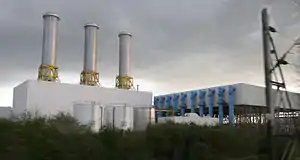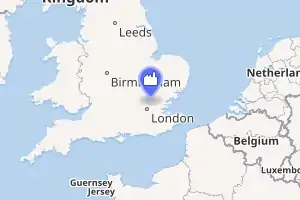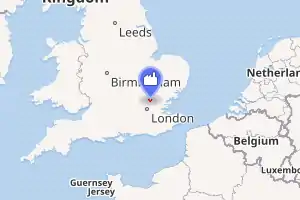Rye House power station
Rye House Power Station is a 715 MW combined cycle gas turbine (CCGT) power station close to Rye House railway station in Hoddesdon, Hertfordshire.[1]
| Rye House power station | |
|---|---|
 Rye House Power Station | |

| |
| Country | England |
| Location | Hertfordshire, East of England |
| Coordinates | 51.763°N 0.009°E |
| Status | Operational |
| Construction began | Early 1990s |
| Commission date | November 1993 |
| Operator(s) | Drax Group |
| Thermal power station | |
| Primary fuel | Natural gas |
| Power generation | |
| Nameplate capacity | 715 MW |
| External links | |
| Commons | Related media on Commons |
grid reference TL387090 | |
History
The current station was built on the site of an earlier 128 MW coal-fired power station built in 1951, and an open cycle gas turbine plant commissioned in 1965 (see below). Both these stations were closed on 1 November 1982[2] and were subsequently demolished.
The gas-fired station, near Hoddesdon, is about eighteen miles north of London, was built in the early 1990s and fully commissioned in November 1993 and officially opened in April 1994. Output from the station is enough to meet the daily power needs of nearly a million people - almost the population of Hertfordshire.
Rye House operates as part of the Drax Group.
Specification
CCGT stations use a gas turbine along with a steam turbine connected to a heat recovery steam generator to provide the most efficient form of thermal electricity generation. Rye House has three Siemens V94.2 gas turbines (generating 150 MW each) rotating at 3000rpm and three Babcock Energy steam generators (receiving exhaust gas at 540C) connected to one Siemens 250 MW HP/LP steam turbine. The plant was built by Siemens. The gas turbines have a terminal voltage of 11 kV and the steam turbine 15.75 kV, connecting to the National Grid at 400 kV. It has the largest air-cooled condenser in Europe. The chimneys are 58 m high. It employs thirty seven people.
Supplemental Balancing Reserve
In October 2014, The station was successful in winning a new contract with the National Grid as a backup energy supply for when there is a shortfall and potential risk of a nationwide blackout of electricity. The contract requires the already successful two shifting CCGT to be fully available and fully manned between the months 1 November and 31 March. After that it would be shut down to rest for the other months of the year.
| Rye House power station | |
|---|---|

| |
| Country | United Kingdom |
| Location | Rye Park, Hertfordshire |
| Status | Decommissioned and demolished |
| Construction began | 1950 |
| Commission date | 1951 (coal-fired), 1965 (gas turbine) |
| Decommission date | 1 November 1982 |
| Owner(s) | British Electricity Authority (1948–1955) Central Electricity Authority (1955–1957) Central Electricity Generating Board (1958–1982) |
| Operator(s) | By owner |
| Thermal power station | |
| Primary fuel | Coal, fuel oil |
| Turbine technology | Steam turbines and open cycle gas turbines |
| Chimneys | 1 |
| Cooling towers | 3 |
| Cooling source | River water and cooling towers |
| Combined cycle? | No |
| Power generation | |
| Units operational | 4 × 32 MW turbo-alternators, 2 × 70 MW gas turbines |
| Units decommissioned | All |
| Nameplate capacity | 128 MW + 140 MW |
| Annual net output | (See graphs) |
| External links | |
| Commons | Related media on Commons |
Coal-fired and gas turbine plant
The 128 MW coal-fired Rye House power station was built by the British Electricity Authority (later the Central Electricity Generating Board) and was commissioned in 1951.[3] The station was located between the London to Cambridge railway line and the Lee Navigation, providing access for the delivery of coal and a water supply for condensing steam in the plant. The building was designed by the architect Sir Giles Gilbert Scott in a steel-framed, brick-clad ‘cathedral of power’ style[4] exemplified by Scott's Battersea and Bankside power stations.
The station had single chimney and three reinforced concrete cooling towers.[5] Each tower had a capacity of 1.3 million gallons per hour (1.64 m3/s).[6] A dock was built on the Lee Navigation adjacent to the power station for unloading coal in addition to the railway sidings.
The station comprised four 30 MW Richardsons Westgarth-Parsons turbo-alternators, generating at 33 kV.[3] These were supplied with steam from the Babcock pulverised coal boilers which produced a total of 1.4 million pounds per hour (176.4 kg/s) of steam at 600 psi (41.4 bar) and 454°C.[3]
In 1965, an open cycle gas turbine power station was built adjacent to the steam station. This comprised two 70 MW oil-fired gas turbine/generator sets.[7] This was a peak shaving plant designed to operate at times of maximum demand.
The output from the steam plant and the gas turbine plant are shown in the following charts.[8][3][6][9]
Rye House (steam) power station output 1954–1982 in GWh.
Rye House (gas turbine) power station output 1965–1982 in GWh.
Rye House power station was decommissioned on 1 November 1982. It was subsequently demolished and then replaced by the CCGT station.
References
- "Rye House Power Station" (PDF). Archived from the original (PDF) on 27 September 2007.
- Mr. Redmond (16 January 1984). "Coal-fired Power Stations". Hansard. Retrieved 1 September 2009.
- "British Power Stations operating at 31 December 1961". Electrical Review. 1 June 1962: 931. 1 June 1962.
- Stamp, Gavin and Glynn Boyd Harte (1979). Temples of Power. Burford: Cygnet Press.
- "Rye House power station, Rye Park, 1953". Britain From Above. 1953. Retrieved 12 April 2020.
- Garrett, Frederick C. (ed) (1959). Garke's Manual of Electricity Supply (vol. 56). London: Electrical Press. pp. A-90-91, A-132.CS1 maint: extra text: authors list (link)
- CEGB (1965). CEGB Statistical Yearbook 1965. London: CEGB. p. 12.
- CEGB Statistical Yearbook (various years 1964-1983), CEGB
- CEGB Annual Report and Accounts, various years
External links
| Wikimedia Commons has media related to Rye House Power Station. |
